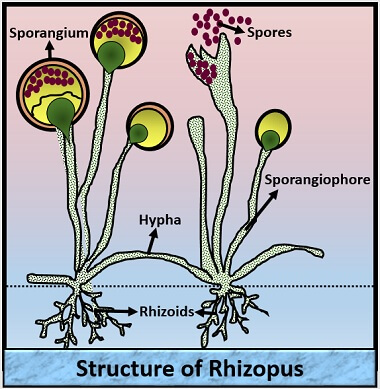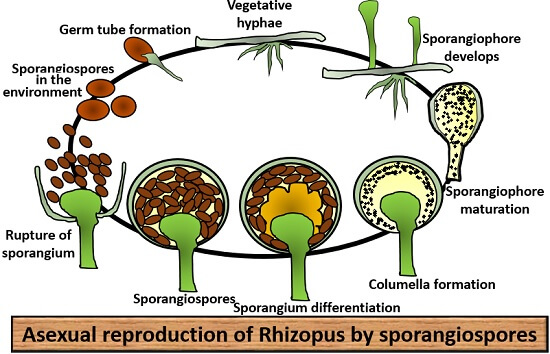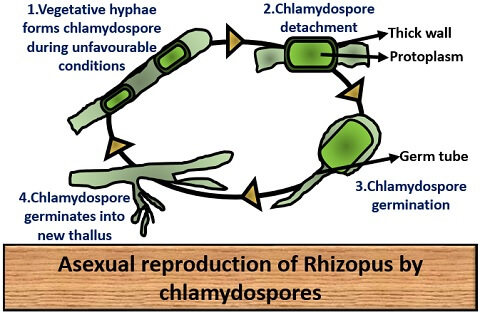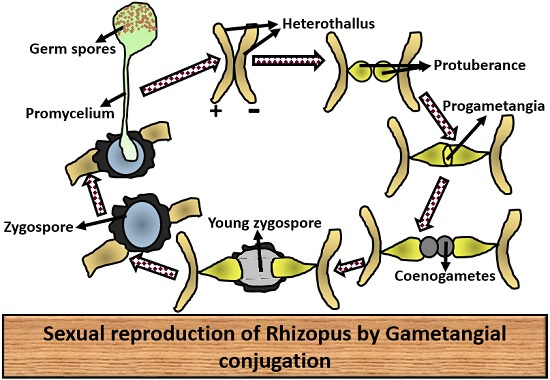Rhizopus is a type of fungus that belongs to the class Zygomycetes, as its species produce zygospore in the sexual reproductive phase. They are also called bread, black or pin mould. These can reproduce by vegetative, asexual and sexual methods through fragmentation, sporangiospores and zygospores formation, respectively. Rhizopus species are cosmopolitan in distribution. It grows on a variety of substrates like fruits, vegetables, bread, jellies etc. There are around 8-10 known species of Rhizopus. Ehrenb first named the term Rhizopus in 1820.
Classification:
- Kingdom: Fungi
- Division: Mycota
- Sub-division: Eumycotina
- Class: Zygomycetes
- Order: Mucorales
- Family: Mucoraceae
- Genus: Rhizopus
Rhizopus species primarily live on dead and decaying matter. It possesses different properties from the moulds by producing sporangiospores instead of conidia. The hyphae of rhizopus species are typically non-septate, fast-growers and white in colour. The main identifying feature of the Rhizopus species is the presence of rhizoids at the base. In this context, we will discuss the features, structure and the different reproduction methods in Rhizopus.
Content: Rhizopus
Features of Rhizopus
There are some important characteristics of the Rhizopus species:
- The mode of nutrition is saprobic and parasitic in Rhizopus, in which a majority of them are saprophytic, and few are parasitic viz. R.artocarp, R.arrhizus etc.
- In Rhizopus, the mycelium is coenocytic, tubular, multinucleated, vacuolated and consists of cytoplasmic materials like Golgi body, mitochondria etc.
- The reserve food material is in the form of glycogen and oil droplets.
- A cell wall of the thallus is non-cellulose and made of chitin.
- The hyphae of Rhizopus differentiates into three distinctive parts, namely stolon (intermodal region), rhizoids (nodal region) and sporangiophores.
- For the growth of Rhizopus, the most important factor is moisture or water availability.
- Its digestion is extracellular.
- These are the opportunistic fungi that commonly cause “Zygomycosis or Mucormycosis”.
Structure of Rhizopus
The morphology of Rhizopus includes the following components:
 Microscopic Features
Microscopic Features
Rhizopus consists of two kinds of hyphae, namely vegetative and reproductive hyphae. Vegetative hyphae differentiate into two types, namely stolon and rhizoids and the reproductive hyphae turn into sporangiophores.
Vegetative Hypha: It typically includes:
- Stolon: It is the intermodal region called Runner. A stolon is the aerial hyphae that grow horizontally, and it is found attached to the substratum. Stolons are aseptate, branched and non-septate (lacks cross-wall).
- Rhizoids: It is the nodal region that eventually forms by the contact between the stolon to the surface of the substratum. Rhizoid is the much-branched structure that forms under the substratum. Its main function is to invade all the nutrients from the substratum.
Reproductive Hypha: It consists of sporangiophores that grow vertically from the stolon. Sporangiophores are unbranched, elongated, columellate, and they give rise to the reproductive structures called sporangiospores. Its cell wall is composed of chitin chitosan, lipids, proteins etc. Its protoplasm consists of many nuclei, mitochondria, endoplasmic reticulum and other cytoplasmic inclusions like the ribosome, oil droplets, vacuoles etc.
Columella: It arises from the sporangiophore and appears dome or umbrella-shaped. The surface of columella can be smooth or rough. The columella is hygroscopic in nature, and its primary function is water absorption.
Sporangium: It attaches with the columella and a long sporangiophore. The shape of the sporangium is spherical or globose. It carries the reproductive structures called sporangiospores. The size of the sporangium is 0.2mm.
Sporangiospores: These are the asexual spores that are globose to ovoid and unicellular. The colour of sporangiospores is hyaline to brown.
Macroscopic Features
- Growth: The growth of mycelium is rapid.
- Appearance: They appear as dense cottony colonies.
- Colour: The colour of mycelium is generally white, and after sporulation, it turns grey or golden brown.
Reproduction in Rhizopus
It reproduces by vegetative, asexual and sexual methods.
Vegetative Reproduction in Rhizopus
Sometimes the thallus of the Rhizopus breaks accidentally or due to some other factors into the few fragments, after which each fragment give rise to a new thallus on favourable conditions.
Asexual Reproduction in Rhizopus
The asexual reproduction can take place through both sporangiospores and chlamydospores.
Asexual reproduction through sporangiospores: It includes the following steps:

- First, the vegetative hypha grows to form sporangiophore that is long and slender.
- Then, the sporangiophore develops and enlarges at the apical region to form columella of variable shape and size.
- This columella gives rise to the large and round sporangium by pushing its cytoplasmic material to the peripheral wall.
- After that, differentiation of sporangia occurs that gives rise to the formation of spore sac in between the sporangia and columella. A spore sac carries the sporangiospores that are oval, unicellular, multinucleate and non-motile.
- These sporangiospores multiply their number within the spore sacs, and the sporangial wall ruptures during the extreme conditions and facilitates the release of sporangiospores out of the wall.
- In the environment, the sporangiospores remain in a dormant or a resting state.
- When favourable conditions return, these sporangiospores form germ tube or undergo germination to develop new vegetative hyphae.
Asexual reproduction through chlamydospores: It includes the following steps:

- During unfavourable condition like insufficient food material and water, the protoplasm is surrounded by a thick and nutrient-rich wall called chlamydospore.
- This chlamydospore then detaches from the vegetative hyphae and remains in the resting phase.
- When this chlamydospore gets moisture, it forms a germ tube or undergoes germination process to develop a new thallus.
Sexual Reproduction in Rhizopus
In Rhizopus, sexual reproduction occurs by the method of gametangial conjugation. It includes the following steps:

- First, the (+) and (-) thallus comes in contact with each other.
- Then conjugation occurs between the positive and negative thalli through an outgrowth developed by positive and negative thalli.
- The septum develops between the progametangium, and eventually, plasmogamy occurs that results in the formation of coenogametes.
- Then, karyogamy occurs by which the gametes of both the (+) and (-) thallus fuse with each other to form a zygote.
- A zygote goes through the maturation phase and becomes encircled by a thick-walled structure called zygospore. There are two layers, namely an outer and inner layer that surrounds the zygospore.
- The zygospore lives in a resting phase for some time. On favourable conditions, zygospore forms a germ tube and germinates by forming a new vegetative body.
Therefore, a Rhizopus reproduces through vegetative, asexual and sexual means to form differentiated hyphae, i.e. vegetative and reproductive hyphae.
Good concept with simple words
I enjoy the lecture with simple, easy breakdown parts.
Simple but detailed explanation with easy to understand english and concept.
Why do rhizopus reproduce both sexually and asexually?
Rhizopus species may reproduce both asexually and sexually in order to continue their life cycle. However, the majority of Rhizopus species undergo asexual reproduction by forming sporangiospores and a few reproduce sexually by forming thick zygospores after the fusion of two compatible mycelia.